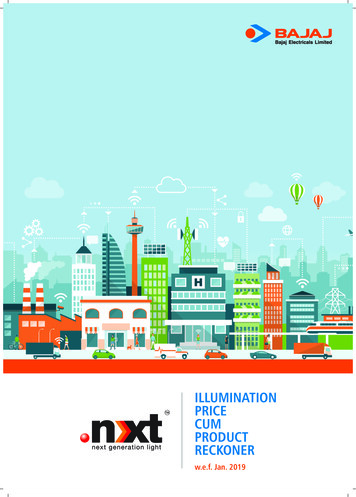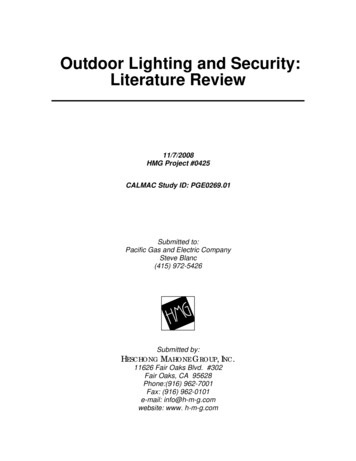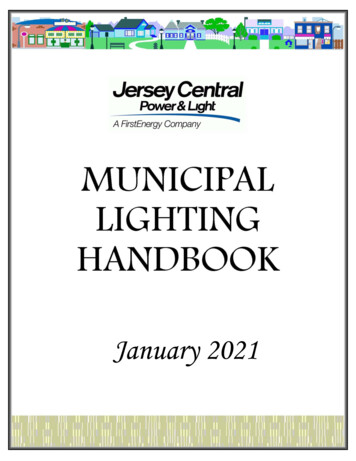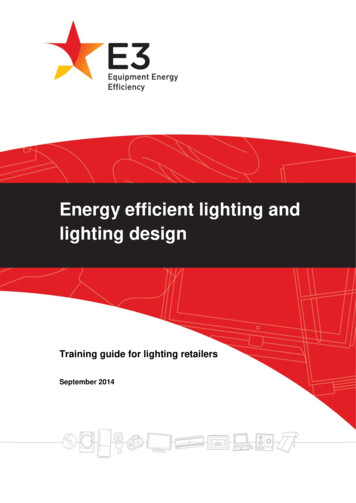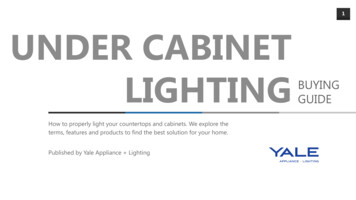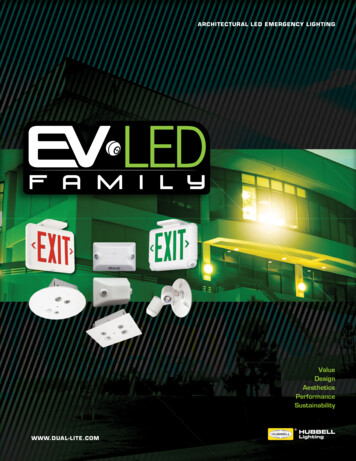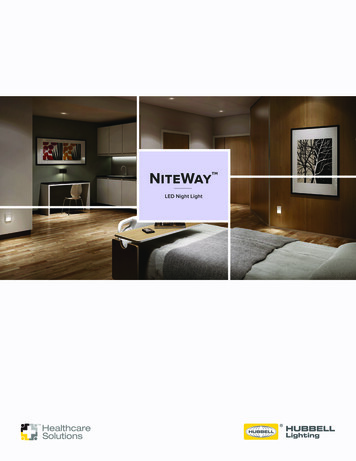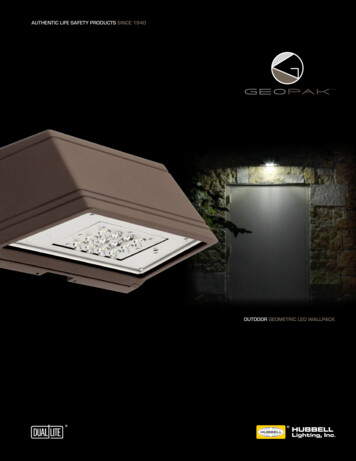
Transcription
SynthLight HandbookChapter 3: Artificial LightingAuthors:Revision:Wilfried Pohl, Andreas Zimmermann6 November 2003
SynthLightArtificial lightingAboutThis is chapter 3 of 5 of the handbook for the SynthLight on-line course onlighting:1. Fundamentals2. Daylight3. Artificial Lighting4. Integrating Artificial Light and Daylight5. Case StudiesFor more material and the other chapters, please visit the SynthLight web ynthlight/index.html.This site also has an on-line test consisting of 15 questions each for each ofthe four main chapters. If you answer more than 80% of questions correctly,you will be sent a Certificate of Virtual Attendance.AcknowledgementsSynthLight was part-funded by the European Commission under the SAVEprogramme. The project number is 4.1031/Z/01-123/2001.DisclaimerAlthough much care has been taken in ensuring that all facts and conceptslaid out in this document are correct, the author can not be held liable for anymistakes that might have crept in. If you discover any inconsistencies, pleasenotify Andreas.Zimmermann@bartenbach.com , so future revisions of thisdocument can be corrected.1
SynthLightArtificial lightingTable of contents3.1 INTRODUCTION33.2 LIGHT SOURCES33.2.1 INCADESCENT LAMPS33.2.2 DISCHARGE LAMPS73.2.2.1 Fluorescent lamps73.2.2.2 Compact Fluorescent lamps113.2.2.3 High density discharge lamps123.2.2.4 Lamp overview143.2.3 USE OF LED TECHNOLOGY FOR LIGHTING153.2.3.1 Basics153.2.3.2 Optical performance163.2.3.3 Life time193.2.3.4 Power supply, circuitry193.2.3.5 Measurement193.3 LUMINAIRES203.3.1 INTODUCTION203.3.2 PHOTOMETRIC REQUIREMENTS203.3.2.1 Luminous intensity distribution213.3.2.2 Luminous flux distribution233.3.2.3 Luminaire efficiency243.3.2.4 Luminance distribution253.3.3 TECHNICAL REQUIREMENTS263.3.4 MATERIALS USED FOR THE REDIRECTION OF LIGHT293.3.4.1 Types of reflection333.3.5 DESIGN OF A LUMINAIRE353.4 LIGHTING DESIGN413.4.1 PROJECT ANALYSIS413.4.1.1 Qualitative objectives423.4.1.2 Quantitative objectives433.4.2 DEVELOPING THE LIGHTING CONCEPT433.4.3 DESIGN DEVELOPMENT443.4.4 CONTRACT DOCUMENTS443.4.5 CONSTRUCTION AND EXCECUTION453.4.6 POSTOCCUPANCY EVALUATION453.5 IMPORTANT DESIGN CRITERIAS463.5.1 ILLUMINANCE LEVELS463.5.1.1 Maintenance rate483.5.2 BALANCED LUMINANCES482
SynthLightArtificial lighting3.5.3 LIMITATION OF GLARE513.5.3.1 Direct glare523.5.3.2 Reflected glare553.5.4 DIRECTION OF LIGHT AND SHADOWS573.5.5 COLOUR OF LIGHT593.5.5.1 Color of light593.5.5.2 Color of surfaces603.5.5.3 Color rendering603.6 COST623.6.1 INITIAL COST623.6.2 MAINTENANCE COST633.6.3 ENERGY COST633.7 REFERENCES643.7.1 PUBLICATIONS643.7.2 CATALOGUES643.7.3 JOURNALS643.7.4 WEB SITES FOR LED643
SynthLightArtificial lighting3.1 INTRODUCTIONAlthough today there is a huge number of different light sources these sources workeither on the principle of thermal excitation or luminescence on one hand, dischargesources on the other hand. A century ago there were only incandescent lamps. Thistechnological pursuit is intensified during the last years in an effort to produce lightsources with higher luminous efficacies, better color rendering properties and longer lifeexpectancies. Of course factors like purchase cost and maintanance cost are by nomeans quite essential for the proper choice.Luminous efficacies were increased enormously through the centuries from 0.01 lm/Wcandle to above 100 lm/W for modern “white” light sources.Torch was probably the first lighting source and fixture as well around 400000 years BCfollowed by simple lamps made of shell and fat around 13000 BC and pottery lamps (withrefined design) around 600 BC. Candle was appeared around 400 AD and was the firstlight source that could be used either in interior or exterior with or without a transparentprotective case.Around 1800 the carbon arc lamps were introduced followed by gas lamps in 1814.Today’s similar incandescent lamp has appeared during 1879 by Thomas Edison withluminous efficacy 1.4 lm/W. High Intensity Discharge lamps introduced in 1901, lowpressure sodium in 1932, fluorescent in 1932 while quartz and metal halide in 1960.It should be mentioned here another innovative light source, the sulfur lamp. It operationis rather simple and can be realized by exciting sulfur and quartz with microwaves withsimilar properties to sunlight but without the ultraviolet component. The lamp itself maylast indefinitely,and the microwave generator may need occasional replacement parts. Lumendepreciation is negligible, and CRI will remain fairly constant.In recent years LED use have become widwspread. There are two possible approachesto produce white light. The first is to use a blue LED coated with a white phosphor (1996).This technology has the disadvantage of short life cycle ( 6 years). The second methodof producing white light is to use additive mixing of the three primary colours red, greenand blue.3.2 LIGHT SOURCES3.2.1 Incandescent lampsThe incandescent lamp is of simple construction - a hot wire (the filament) centred in theglass bulb. An electric current that passes through the wire heats it to incandescence.Thus, the wire emits radiation respectively light. The length and the diameter of the wiredetermine the amount of electrical current consumed by the lamp. This regulates its lightoutput.4
SynthLightArtificial lightingThe elements of a tungsten filament lampDue to its high melting temperature (3.,655 K), tungsten is used for filaments. The higherthe temperature at which the filament operates the more light can be emitted but thesooner the lamp fails or burns out. Lamp bulbs originally were evacuated to prevent areaction of tungsten with oxygen, which would cause the quick evaporation of tungsten. Inmodern incandescent lamps the bulb is filled with an inert gas which slows bulbblackening. Especially argon, nitrogen and krypton gases are used for this task. Bulbblackening is caused by condensation of evaporated tungsten particles on the inner bulbwall.Although reduced by the inert gas pressure, the filament evaporation continuesthroughout life. The tungsten wire becomes thinner, consumes less power and emits lesslight. This light loss combined with the bulb blackening causes a steady decrease in lightoutput throughout the life of the lamp.The higher the voltage an incandescent lamp is operated the higher its efficacy causing ahigh light output. Overvoltage, however, results in shorter lamp life. Under voltage resultsa lower efficacy causing a low light output but increases lamp life.5
SynthLightArtificial lightingLamp life versus light fluxAs regards energy-saving lamp life is very important. By mean average life we mean thespan of time which 50% of all incandescent lamps work under normal operatingconditions.Reducing wattage can prolong the chart lamp life, causing, however, a reduction inefficacy and light output. This is how extended service incandescent lamps achieve theirlong life (2500 h). Their lumen output is approximately 15 % less than standard 750-hrand 1000-hr life lamps. Although these lamps are more expensive than standard ones,their longer life is advantageous in locations that are difficult to relamp. Luminous efficacycan be improved by using a coiled coil filament and by filling the glass bulb with halogengas. This measure ensures that the evaporated tungsten atoms redeposit themselves onthe filament in a closed cycle.The main advantages of a halogen lamp are a higher luminous efficacy of up to 25 lm/W,a longer life of approx. 2,000 h, a white colour and constant light flux throughout its life.Low voltage lamps:The wattage of an incandescent filament lamp is defined as the product of the voltagedelivered at the socket multiplied by the amperes flowing through the filament. To achievecertain wattage of a filament lamp using low voltage a high current is necessary. Thishigh current requires large diameters of the filament to carry it. A filament with a largediameter can be operated at higher temperatures, which increases efficacy. Furthermore6
SynthLightArtificial lightinga large diameter allows for a more compact filament, which enables a precise beamcontrol. This is one of the biggest advantages of low voltage lamps.Due to the point-like source, these lamps are often combined with high-precisionreflectors. Thus, extremely concentrated beams of light can be achieved. Low voltagereflector lamps with narrow beamspreads are energy-saving when their concentrateddistribution is used to light small objects or large objects at a great distance.If a lighting system fitted with low voltage tungsten halogen lamps is to be investigatedfrom an economic viewpoint, we must not forget that low-voltage lamps need a suitabletransformer for operation. The transformer converts the mains voltage of normally 230V(primary side) into the low voltage required which is normally 12V (secondary side).Conventional transformers use different coils on the primary and secondary side. Theyare larger and heavier than the ring core transformers that were developed at a later date.Due to their relativeley large loss of power, energy can only be saved with transformersthrough the use of modern electronics. Electronic transformers are operated with highfrequencies. Their power loss is two thirds less than that of conventional transformers.Furthermore, due to their lamp-saving operation (stable voltage) they prolong the life oflamp because only 5% over voltage reduces the life of lamps to 50%.Less loss of power also reduces the heat generated. This is particularly advantageousbecause low-voltage reflector lamps and transformers are often built into ceiling cavities.As they can also be operated with direct current, electronic transformers are also suitablefor emergency lighting. Furthermore, electronic transformers can also be dimmed.Comparison of sizes: General service lamps, low-voltage halogen lamps, low-voltage halogen lampswith reflectors7
SynthLightArtificial lightingOverview of incandescent lamps and their xlmLuminousintensitycdLuminousefficacylm/WColour andColourrenderingLifehGeneralService .300----180.40000----ww/12000High voltageTungstenHalogen 00----14.2214.17ww/12000Low voltageTungstenHalogen lampReflectorAl or glassGy 6,35G45.15050.3200----10.21ww/12000Low voltageTungstenHalogen lampwith reflectorclearmattGu 5,3Gy 410.250----600.45000----ww/12000.4000Overview of incandescent lamps and their specifications3.2.2 Discharge lamps3.2.2.1 Fluorescent lampsFluorescent lamps contain mercury vapour with extremely low pressure. Electrodes arelocated on both ends of the fluorescent lamp. The electrons hit mercury atoms on theirpath through the discharge tube. Upon collision, the mercury atoms are shortly excited.The absorbed shock energy is immediately released in the form of invisible UV radiation.While passing through the fluorescent layer on the inner side of the discharge tube, theshortwave UV radiation is partially transformed into visible light.8
SynthLightArtificial lightingDuring these processes, the electric power supplied is not only transformed into visiblelight but also, to a considerable extent, converted into other forms of energy such as heat.Energy balance of fluorescent lampsAs mentioned at the beginning of this chapter, a starter is needed to ignite dischargelamps and a ballast is needed to operate them.Fluorescent lamps have a disadvantage in that the voltage drops when the power rises.That means that the lamp will consume more and more power until it no longer works. Toavoid its self-destruction, the power supply is limited by means of a ballast.To date, conventional choke coils have been used as current limiters. They are made ofan iron core wrapped in copper wire. A 1.5-m long fluorescent lamp with a 58W wattagecauses a power loss of 13W in the choke. That means that the system, i.e. lamp andballast, altogether consume 71 W.Less power is needed if the conventional ballast is substituted for a low-loss ballast. Lowloss ballasts use less but thicker copper wire and have a better iron core. As a result,power loss at ballasts is reduced to 8W with the lamp mentioned above. That means thatthe wattage of the system, i.e. lamp and ballast, amounts to 66W.The greatest energy savings of up to 25% can be achieved by using electronic ballasts.With approx. the same light flux, the system s wattage (lamp and ballast) can be reducedto 55W.9
SynthLightArtificial lightingWhile conventional and low-loss ballasts operate at a frequency of 50 Hz, electronicballasts operate at a frequency of between 25,000 and 40,000 Hz.As the luminous efficacy of fluorescent lamps increases with increasing frequency, eithera higher light flux is achieved with the same power loss as at 50 Hz (e.g. 58W), or approx.the same light flux as at 50Hz is produced with less power being consumed by the lamp.Luminous efficacy of fluorescent lamps operated with electronic ballasts at various frequenciesLamp life of fluorescent lamps:To indicate the life of fluorescent lamps, their useful life is defined. It is the time requireduntil the system’s light flux is reduced to 80% of its initial value (new value).The system’s decrease in light flux can, however, be traced back to the following:- a decrease in light flux due to burning period of lamp(fatigue of fluorescent material)- lamp failure- dirt accumulationThe useful life of a lamp strongly depends on its operation. Fluorescent lamps operatedwith conventional ballasts last approx. 7,500 hours, those operated with electronicballasts last from approx. 25,000 to 50,000 hours.10
SynthLightArtificial lightingUseful burning life of fluorescent lampsTypes of fluorescent lamps and their cacyind.conv.Ballastlm/WLight ww/1Types of fluorescent lamps and their specifications117500
SynthLightArtificial lighting3.2.2.2 Compact fluorescent lampsa) CFL with built-in ballastsThe major disadvantages of incandescent lamps are their low luminous efficacy ofapprox. 12 lm/W and their relatively short life (1000-2000 hr). The advantage they have,however, is their size.Depending on how fluorescent lamps generate light, lamps have been developed whichalready include the necessary ballast and, analogous to general service lamps, have theirown lamp base. Although these lamps cannot be dimmed, due to the higher luminousefficacy of approx. 50 lm/W and their 8-fold life of approx. 8,000 hours, they are the idealsubstitute for incandescent lamps, from an energy-saving viewpoint. That is why theselamps are also known as energy-saving lamps.Analogous to fluorescent lamps, they can be equipped with conventional (inductive) orelectronic ballasts. With the latter, these lamps have a higher luminous efficacy,guarantee an immediate, flicker-free start and weigh less. Due to the low consumption ofpower required to achieve approximately the same light flux and the long life of theselamps, both energy and maintenance costs (lamp replacement) are saved.Due to the diversity of glass bulbs, these lamps are mainly used to replace tungstenlamps in restaurants, salesrooms, homes and rooms with decorative lighting.b) CFL with external ballastsCompact fluorescent lamps with external ballasts generate light according to the principleof fluorescent lamps. These lamps have thin, parallel fluorescent tubes, a built-in starterand a base. The lamps generate a light similar to that of tungsten lamps, have a highluminous efficacy and a life of 8,000 hours. The ballasts for their operation must beincorporated into the luminaire.The lamps’ low weight, small size, high luminous efficacy and long life are the mainadvantages of this lamp. They are normally applied in homes, restaurants and places,where economical lighting is desired.Lamps that are both compact and powerful are used in special fittings for the direct and/orindirect illumination of offices.Various compact fluorescent lampsCompactfluorescentlampswith cketLuminousefficacy /180001lm/W2G75.26250.180042.50ww/180001G R 10q16.281050.205050.57ww/112 G 1118.551200.480040.79EVGnw/1ww/180008000(10000with EVG)Various compact fluorescent lamps121
SynthLightArtificial lighting3.2.2.3 High intensity discharge lamps (HID)The term high-intensity discharge applies to arc-discharge sources with a high powerdensity. With most HID lamps, the arc tube is enclosed in an outer glass bulb.As with fluorescent lamps, HID lamps require ballasts to regulate the arc current flow andto deliver the proper voltage to strike the arc. Electronic ballasts are more efficient andprovide more precise control of the arc tube voltage over life, resulting in more consistentcolour and longer life.Before the lamp will relight, it must cool sufficiently to reduce the vapour pressure to apoint where the arc will restrike. The time required to cool depends on a luminaire s abilityto dissipate heat. Typically in a luminaire, HID lamps will relight in 3 to 10 minutes.HID lamps used for illumination in buildings belong to three principal families:1) mercury-vapour lamps2) high-pressure sodium lamps3) low pressure sodium lamps4) metal-halide lamps1) Mercury-vapour lampsWith mercury vapour lamps, light is produced by an electric discharge through mercuryvapour, resulting in poor quality of a greenish hue. The addition of phosphor coatings onthe inside of the bulb improves colour rendering because phosphor complements the redpart of the spectrum.2) High-pressure sodium lampsHigh-pressure sodium lamps are manufactured with tube-shaped ellipsoidal bulbs withwattage of between 50 W and 1000 W. The discharge space is a transparent ceramicburner, which is resistant to the aggressivity of sodium. High-pressure sodium lampsachieve a extremely high luminous efficacy up to 130 lm/W, however, they radiate ayellowish colour of light and achieve bad colour rendering. Thus, these lamps are onlyused in warehouses and similar locations when used in interiors; their main application isoutdoors for the illumination of streets and car parks.3) Low-pressure sodium lampsThese lamps have high efficiency (up to 180 lm/W), quite long life (up to 16000 hours)and reduced running costs. As their name implies sodium in the lamp causes the light tobe a yellow color. This might be a problem in cases where color discrimination isessential. LPS is commonly used for road lighting, parking areas etc. They can be usedwith black & white surveillance cameras. Another advantage is that these lamps can beused in areas where astronomical observations take place since its yellow light can befiltered out. A short warm-up period is needed for the lamp to reach full brightness.13
SynthLightArtificial lighting4) Metal-halide lampsHigh-pressure metal-halide lamps are a further development of high-pressure mercuryvapour lamps. Through the addition of various blends of metal halides, the luminousefficacy is about 95 lm/W. In addition, colour rendering is improved considerably, certainmodels even achieving the excellent colour rendering value 1.The lamps are available with an ellipsoidal bulb with wattages ranging from 250W to1000W; their wattage increases to 3500 W when shaped like a tube. Single and doubleended lamps with a lower wattage are also available with wattages beginning from 35 Wthat are particularly suitable for the energy-efficient lighting of offices, salesrooms andwindow-shops.Overview: Metal Halide and High Pressure Sodium LampsPowerLampMercuryvapour edWlmlm/Wellipsoidscattering withfluorescent 0.30000069.110tw,nw1A 000073.86tw1A,1B6000yesellipsoidclear, ulartubularclearno outer yes2000.3500 170000.3000001000.2000 90000.20000033Overview: Metal Halide and High Pressure Sodium LampsCharacteristics of metal halide lamp up to 150 W141600016000nono
SynthLightArtificial lighting3.2.2.4 Lamp overviewLamp type overview according to luminous efficacyComparative energy balances15
SynthLightArtificial lightingLamp type overview according to colour temperature3.2.3 Use of LED-technology for lightingFor most people, light emitting diodes (LED) are the perfect replacement for conventionallight sources with an enormous life time and a very high efficiency. These optimisticperformance characteristics are a result from a strict publicity drive at the very first yearsof LED development. Unfortunately it was just partial possible to reach these ambitiousgoals up to now.3.2.3.1 BasicsLight emitting diodes (LED) are light sources based on electro luminescence and are verysimilar to conventional semiconductor diodes. The light is generated in the depletion layerby the recombination of electrons and hole, the emitting spectra is depending on thecomposition of the semiconductor material. Beside the typical colored LED also whiteLED's are available since several years. The white radiation is not the direct result of theLED emission but is generated by fluorescence conversion in blue LED's covered with aphosphor layer.In contrast to conventional light sources no infrared or ultraviolet light is emitted, thegeneration of the more or less narrow band light requires low voltage in the region ofseveral volts depending on the color (e.g. 2V for red, 3.6V for blue). Due to theirconstruction LED's are not sensible to mechanical shock. The size of the active lightemitting area is typical smaller than 1 mm2 and acts quasi as a point source.16
SynthLightArtificial lightingOverview on typical available LED's3.2.3.2 Optical performanceDesign, emitting characteristicsSince the first LED application like indicator lights in electrical devices in standard 3/5 mmlayout, several different types in SMD (surface mount device) or COB (chip on board)have been developed. All of these layouts have their typical emitting characteristics, froma very narrow beam to more or less diffuse radiation, depending on the design of theemitting area and the design of the incorporated optics. These optical behavior has agreat impact on the usage of LED's in lighting: either the optics is too perfect and yields adirect image of the emitting area or the light distribution is not homogeneous and shows acircular behavior. Also the available light flux per LED is too low for a reasonableapplication in lighting.17
SynthLightArtificial lightingLlight distribution of Agilent HLMP EL16 and Nichia NSPB500But some LED types are available, which can partially be used for lighting (e.g. LuxeonStar/O with collimating optics or Tridonic PowerLED). Also additional optics has beendeveloped (lenses, parabolic cut-off devices) to improve optical behavior.Cut-off device from Bartenbach LichtLabor, Austria, for Osram PowerTOPLED and aspherical opticsfrom Fraen, Italy, for Luxeon EmitterColor rendering and correlated color temperatureThe spectral behavior (spectral distribution) is also important in lighting applications andcan be summarized in two parameters: color rendering index CRI and correlated colortemperature CCT. Due to the generation process of white LED light (based onfluorescence conversion and mixing), corresponding spectra show the typical blueexcitation peak and the fluorescence converted broad yellow part. Depending on themanufacturer these spetra yield a CRI between 70 and 80 and a CCT between 4000 and6500K. High color temperatures and low color rendering are not useful in general lightingapplications. An improvement of the values is possible due to new LED technology(improved phosphor coating, RGB mixing, UV conversion) or due to spectral addition.18
SynthLightArtificial lightingNichia NSPW500Luxeon Emitter white 1WOsram PowerTOPLED LW E67CTridonic powerLED1,0Intensity ,0400450500550600wavelength [nm]650700400750450500550600650700750wavelength [nm]Comparison of different white and typical colored LED spectraLi ht W ibj / 17 04 03 / AZSpectral mixingAs shown above, white LED's are not perfect for lighting due to the CCT and CRI. Thereason for this is the typical spectra with a clearly visible deficit in the blue around 500 nmand in the red region above 600 nm. The missing of these spectral region causes the badcolor rendering and in addition with the blue peak the high color temperature. But it ispossible to overcome the spectral deficit by adding for example cyan and red LED light.composition: CRI 92, CCT 5280Kwhite LED only: CRI 74, CCT 5750Kcyan LED onlyred LED only1,0Intensity [a.u.]0,80,60,40,20,0400450500550600wavelength [nm]650700750Spectral composition of white, cyan and red LED'sEfficiency, light fluxThe efficiency of colored LED's has outrun the efficiency of filtered conventional lightsources, the efficiency of white LED's (η 20 lm/W) is at the moment comparable withhalogen lamps and on the best way to beat them. One problem is that the LED efficiencyis decreasing with increasing temperature which makes active cooling of the LED-emitteressential. Due to the low emitted light flux per LED (φLED 1-100 lm) the usage of LED'sin lighting application is at the moment limited (for example a 50W halogen lamp deliversa light flux of φ 1000 lm).19
SynthLightArtificial lighting3.2.3.3 Life timeBased on the very first estimations, an extrem LED life time with 100.000 h and a more orless endless light output is in all mind. Maybe this is correct for underpowered red orgreen 5mm indicator LED's but not for white LED's. Latest measurements reveal a lifetime of 7.000 – 10.000 h for standard 5mm white LED. The reason therefore is a haze inthe covering epoxy due to the cracking of the polymer molecules by the emitted blue light.3.2.3.4 Power supply, circuitryDespite advertisement, LED's are not a simple one-to-one replacement for conventionallight sources, the circuitry is more complex due to strict voltage and current restrictionsand due to the polarity. But complete solutions with LED modules and appropriate powersupplies are available from several manufacturers. This simple plug and play solutionsare very efficient for several applications like effect or color lighting. For prototypeapplications these ready solutions are mostly not useful, custom made power supplies arenecessary. Also special types of dimmable power supplies are available.3.2.3.5 MeasurementClassic measurement techniques in lighting business is based on broad band detectioncells optimized for conventional light sources light incandescent lamps. These detectioncells are modified to follow the spectral response of the human eye by incorporatingspecial filters. The measured brightness reproduce our subjective perception by anaveraged detection in the spectral region between 380 – 780 nm. This averaged detectionresults in a more are less accurate measurement for broadband and spectral smooth lightsources. In case of narrow band LED emission, especially in the blue and red region, thedetection filter exhibit a deviation from the photopic luminous efficiency function whichcause a substantial detection error which must be taken into account for an accurateanalysis. If accurate LED measurements are required, the spectral composition of theLED light source as well as the spectral response of the detector is required. In addition tothe inherent measurement uncertainties, at the time no international standards areexisting. The CIE is at present the only organization which has released guidelines forLED measurements (CIE 127-1997 "measurements of LED's").1001relative response error [%]measuring cellv(λ)spectral 800500-50-100wavelenght [nm]450500550600650700wavelength [nm]Spectral response of a typical light measuring cell and deviation from the CIE luminous efficiencycurve20
SynthLightArtificial lighting3.3 LUMINAIRES3.3.1 INTRODUCTIONA luminaire is a complete lighting unit consisting of one or more lamps (light sources)together with optical and mechanical components. It is designed to operate the lamps,that means to position and protect the lamps and to connect them to the power supply.The main function of a luminaire is to realise a lighting concept which fulfils the visualtask.It does not suffice to merely achieve the recommended minimum lighting intensities (inkeeping with the standards).To allow light to convey visual information, luminaires must generate a balanceddistribution of brightness and/or luminance in connection with the right choice of finishesfor the space-defining surfaces (ambience).From the viewpoint of a lighting designer, high-quality-luminaires must satisfy all- Photometric requirements (distribution of luminous flux, luminaire efficiency, limitation ofglare, .),- Technical requirements (protection classes, safety of operation.).Due to the increasing cost of electricity in the past decades, increasing demand
In recent years LED use have become widwspread. There are two possible approaches to produce white light. The first is to use a blue LED coated with a white phosphor (1996). This technology has the disadvantage of short life cycle ( 6 years). The second method of producing white light is to



